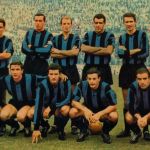
History of the aesthetics of the Dea
From the fusion between Atalanta and Bergamasca up to the Champions League Final 8
July 20th, 2020
It is one evening in October 1907 when five twenty-year-olds decide to create the Atalanta Gymnastic and Athletic Sports Club of Bergamo, with a name that declares from the beginning the intention to create a society that has ambition, hunger and propensity to win, characteristics own of Atalanta, mythological figure famous for being the most ferocious hunter in all of Greece.
Now the Dea faces the great European football with an awareness that no one would expect from a provincial who has been on extra-Italian courts for just two years; the enthusiasm dictated by Gasperini's game and by an environment that supports you regardless of the result certainly helps, but being able to maintain such a high level of performance despite the problems dictated by Covid-19 is something worth highlighting; it seems that the Goddess has a higher gear and in such a particular moment for the city of Bergamo it is difficult to appease the dreams and ambitions of the team and its fans.
THE JERSEY
The Atalanta shirt has not always been nerazzurra: in Bergamo for 30 years there have been two teams: Atalanta, founded precisely in 1907, who wore black and white shirts, and Bergamasca, a sports club founded in 1877 that used white colors and blue. Only in 1920, the year of the merger between the two companies, it was decided to eliminate the color common to both teams to adopt the Nerazzurri.
At first it was a broken nerazzurri style ''Barcelona of the centenary'', only to introduce lines that have lasted up to the present day, a semi-compulsory choice with the conservative character typical of the average Atalantino fan, who would struggle to accept a radical change in the design of its third shirt (like the case of the yellow and black one of the 2013/2014 season), let alone the first.
Despite the few changes, over the years there have been a series of sponsors (both jersey and technicians) who have occupied part of the Bergamo iconography from the first moment: as regards the sponsors ''on the chest'' we talk about Sit- In, remained on the Nerazzurri shirt from 1981 to 1989 and from 2005 to 2010, Tamoil, from 1989 to 1995 and Somet, which instead appeared in the golden years of Pippo Inzaghi and Bobo Vieri from 1995 to 2000.
As for the technical sponsors instead, before the ''lucky'' Joma there were the iconic NR between 84 and 86 and from 89 to 91, Lotto, which produced unforgettable shirts between 1991 and 1994 , Asics, which represents the most enduring technical sponsor, used from 1994 to 2007 and Erreà, who took the place of Asics until 2014.
So many sweaters, so many patterns, so many templates but none of the sponsors has ever dared to turn around, always ending up producing a first sober shirt, with slightly different variations for shorts and socks that were also white and blue, and a second always white shirt with nerazzurri details. The need to find whimsical designs therefore fell on the third jerseys or on the celebratory jerseys that have never had a predefined color but which, especially for marketing needs, were produced in colors that have nothing to do with identity or even less with the city, like the green ones produced in the Christmas Match or the third green jersey of this year.
THE LOGO
The identity of the club, on the other hand, is directly associated with the figure represented within the logo, Atalanta, whose nickname, the ''Dea'', is actually inaccurate: in fact, King Iaso, his father, was only a distant descendant of Arcadio - one of the sons of Zeus - reason why we are led to think that this is a designation studied at the table, and that the most correct one is the "Princess". But anyway: legend has it that Atalanta, sent into exile by her father - furious that a daughter was born to him - once she became an adult, was forced to find a husband against her will; as a compromise, the Goddess agreed with her father that she would marry only those who could defeat her in a speed race, knowing that she would never be beaten. And in fact no one succeeded, but only without help: the winner, Hippomenes, beat her thanks to three apples that distracted Atalanta who, during the challenge, stopped to collect them intrigued by their color, gold. A color that, in addition to the social ones, will often appear inside both the shirt and the Atalanta logo.

The first logo dating back to Atalanta - intended as the merger of Atalanta and Bergamasca Calcio - dates back to 1963, the year in which for the first time a golden goddess appeared intent on running flanked by four nerazzurri bands, different from those of the previous crest which instead took their cue from the first social colors, that black and white that belonged to the Bergamo area.
Only since 1984 has been introduced part of the coat of arms that we know today: Atalanta was initially represented in full, but from that moment on only the face began to be represented, faithfully recovered in the evolution of 1993, the coat of arms that has remained club officer. Going into detail, the stylistic line shown in the representation must be sought in the hair: in each coat of arms, the attempt is to immortalize them in motion, trying to photograph Atalanta in the characteristic that has always distinguished it, that is speed; for this reason, in the current emblem the face has been angled slightly upwards, since running the head naturally tends to go backwards.

Even the diagonal that divides the symbol provides this sense of speed always sought by the designers, who through these choices have managed to pack a geometrically anarchic emblem: the efficiency of the design, however, lies precisely in the stylistic balance of the final effect, where with great care have been joined circles, diagonals, ovals and different angles.








































.png)


.jpg)






















































